Conor Brockbank, Modern History Graduate, Aberystwyth University
During the Second World War, nationals from Germany and Austria, many of whom had their citizenship removed and had found refuge in Britain in the years before the war began, were subjected to the judgement and suspicion of being “enemy aliens”. Austrians, it is important to note, had faced the Anschluss, an annexation of their country by Nazi Germany in March 1938. Nevertheless, they were viewed as Germans following the introduction of wartime “enemy aliens” policies in Britain.
But what did the term “enemy alien” truly mean? How was it decided that German and Austrian nationals in Aberystwyth and Britain more widely were deemed “enemy aliens” and a risk to the security of the country? Who were these German and Austrian nationals and, importantly, how and why did they end up in the seaside town of Aberystwyth, miles from their homelands, and subject to potential internment? What was their fate? What were their individual experiences of the tribunals and judgements they faced? The following series of blog posts will explore these questions and add depth to the names and photos of some “enemy aliens” collated in a notebook by the Cardiganshire Police, as well as those people whose names are only present in the Aliens and Regional Advisory Committee tribunals records, held in Aberystwyth in 1939 and 1940.
Among the 600 students as well as staff members who were evacuated from University College London (UCL) to Aberystwyth were 15 students and four members of staff and their families, who were subject to these tribunals to judge if they were “enemy aliens”. Their evacuation among others from Birmingham and South Wales, according to the County of Cardigan Standing Committee minutes for the 3rd of October 1940, was a clear concern and focus of the Chief Constable, J.J. Lloyd Williams, and the Cardiganshire Police Force as he notes:
Owing to the bombardment of the South Wales, London and Birmingham areas, a very considerable influx of evacuees has occurred … These unofficial evacuees include many aliens and considerable additional work has been imposed on the aliens staff at Aberystwyth through these individuals taking up their residence here.
This additional work mainly involved undertaking tribunals, of which Aberystwyth was one of 120 places that tribunals were held across Britain, to ascertain if the Germans and Austrians present needed to be interned or subjected to certain restrictions. These decisions were made in-line with the categories set out by the government to classify them as either a “refugee from Nazi oppression” or as a “non-refugee”, with them assigned ‘A’, ‘B’ or ‘C’ to indicate their fate, be that:
‘A’: Internment,
‘B’: Travel was limited to five miles from their place of residence, with permission for travel at any greater distance requiring the permission of the police (owning a camera or binoculars was also forbidden),
And ‘C’: Exemption from restrictions and internment. They had the opportunity to have their status as a ‘Refugee from Nazi Oppression’ indicated and acknowledged on official documents.
These restrictions enforced on German and Austrian nationals in Aberystwyth and elsewhere, as well as the policy of internment, were possible under the power and laws of the Alien Acts of 1914 and 1919. All evacuees from UCL who were subject to the Alien tribunals between 23 and 27 October 1939 were initially categorised as ‘C’ (“refugees” rather than “enemy aliens”). Historian Rachel Pistol argues that at the time, being assigned category ‘C’ was seen as an indication of innocence. No doubt many of those who were evacuated from UCL to Aberystwyth viewed their category ‘C’ as such. This categorisation was also, according to the political scientist Neil Stammers, the initial fate of 64,000 Germans and Austrians in Britain, with only 6,800 being categorised ‘B’, and an even smaller amount of 569 being categorised as ‘A’ and in need of immediate internment.
However, this decision by the Aliens Tribunals in Aberystwyth, as well as the decision to categorise most Germans and Austrians in Britain as category ‘C’ in 1939, was overturned by the government’s conclusion between 11 and 17 May 1940 to begin the mass internment of all male “enemy aliens” in Britain. This policy was agreed despite the reservations of notable cabinet ministers such as the Leader and Deputy Leader of the Labour Party, Clement Attlee and Arthur Greenwood, as well as the then Home Secretary, Sir John Anderson. Stammers argues this change was due to the fear that many Germans and Austrians were an internal threat to the security of Britain, as it was believed and promoted by the newspapers of the day that they were sympathetic or working for the Nazis. Furthermore, the progression of the war, with the invasion of the Low Countries (Belgium, Luxembourg, and the Netherlands) and France in May 1940, and the change in government from Prime Minister Neville Chamberlain to Winston Churchill, brought a new direction and individuals to the discussion table. This ultimately changed the overall opinion of the government towards the matter of mass internment.
Near the end of June 1940, the fate of all German or Austrian men was decided, as any male categorised as ‘C’ was now subject to internment. The realities of these decisions made in London came to affect those who had initially been evacuated around 232 miles to the seaside town of Aberystwyth to protect them from aerial bombardment. Between 4 and 19 June 1940 many were taken from their allocated educational safe haven of Aberystwyth to be interned as “enemy aliens”. This was the fate of 24 Germans and Austrians resident in Cardiganshire by 3 October 1940, according to the County of Cardigan Standing Committee minutes.
The individual stories and fate of these 16 students and three members of staff of UCL are in some ways similar, but in others are totally unique, in both how Aberystwyth became their temporary home away from home and how they then adapted to such upheaval in their lives. This first blog will explore the small group of UCL evacuated students who were themselves not interned.
Of the evacuated German and Austrian UCL students, only four were not interned at all, alongside one Polish student. Many of these students were women and therefore not included in the new policy to intern all male “enemy aliens”. Two of these students whose lives after their time in Aberystwyth are unknown, were Stefanie Mira Fink (pictured below), who was a Polish student studying for a BA General, a multidisciplinary degree that covered a wide range of subjects; and Johanna Friedstein. Johanna was born in October 1917 in Vienna, Austria and was living at Holborn House on Queens Road throughout her evacuated studies at Aberystwyth. The three remaining evacuated students came from a variety of backgrounds, such as Dina Rosenblüth who was born in May 1919 in Wilmersdorf, a residential district in Berlin. She was a psychology student in Aberystwyth who had been educated in England after her family had emigrated from Germany in c.1938 after the Nazis rose to power. The Rosenblüths, consisting of Dina, her brother and mother, were living in Hendon, London in 1939, where Dina began her studies at UCL. Her father was a judge in Berlin before they left Germany and later went on to help establish the state of Israel, becoming the country’s first Minister of Justice. During her time in Aberystwyth, she lived at Hafodynys on Victoria Terrace. From the 1950s onwards, Dina published many articles and books which focused on child psychology and psychoanalysis. She passed away in July 1983 in Tavistock, England.
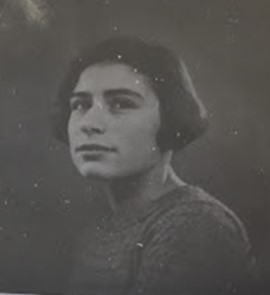
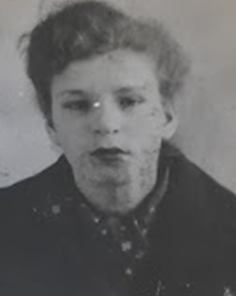
Stefanie Marie Fink (left) and Dina Rosenblüth, 1919-1983 (right), photos within Police Memorandum Book inscribed ‘Aliens’ Photographs’, H.W.?Owen, MUS/204, Archifdy Ceredigion Archives
Ruth Irmgard Bringfriede Liefmann was another UCL student who was not interned. Ruth was born in March 1916 in Hamburg and had left Germany before WW2 began. In November 1939, she was a sports teacher in Swanage in England before moving to Aberystwyth as a student at the Chelsea Physical Training College. She lived on Bryn Road during this time. It was believed among her pupils later in the war at Holyrood preparatory school in Abermad that Ruth would have competed as a long jumper in the 1936 Olympics that were held in Berlin, if she had not been prevented from doing so because of being Jewish. Ruth was a popular teacher at Holyrood, where she taught German to her pupils. Her commute to work during this time was a short one, as she lived in a lodge at Troed-y-rhiw, Llanfarian. Teaching remained her occupation until she retired as a college lecturer in Hampshire. Ruth passed away in Hampshire in September 1991.
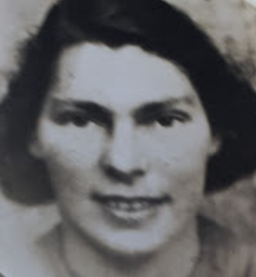
Hans-Hermann Arnold was the only male UCL evacuated student who was not interned for a unique reason. Hans-Hermann was born in Berlin in December 1915, the son of Eberhard and Emmy Arnold, the founders of the Bruderhof, an Anabaptist Christian community originally formed in Sannerz, Hess in Germany. After Eberhard and the Bruderhof community’s resistance and awareness of the impacts of Nazi ideology, the community (then based in the Rhön Mountains) was stormed by the Gestapo on 16 November 1933. The community moved to Liechtenstein and later set up further communities in the Netherlands and in the Cotswolds in Ashton Keynes, England in 1934 and 1936 respectively. After his father’s death in November 1935, Hans-Hermann with his brothers and brother-in-law took charge of the running of the various communities, and he joined the Cotswold Bruderhof around March 1936.
His university education began in Manchester University in early 1936, however, after failing his exams, Hans-Hermann changed his degree course to History and enrolled in this subject in 1938 at UCL. Alongside his fellow UCL students he was then evacuated to Aberystwyth. His wife, Gertrud, whom he had married in June 1938, later described her husband’s new surroundings after being evacuated from London as ‘an old castle directly on the rocky coast’ and that ‘(a)t the swell of the sea, the spray of the waves came up to the windows’. The ‘old castle’ that Gertrud describes was the main University building of the University College of Wales, Aberystwyth, which is now known as the Old College. At this time, Hans-Hermann travelled earlier than the rest of his fellow students to Aberystwyth to find suitable accommodation for his relatively new family to live, as Gertrud had given birth to their first child, Rose Marie at the Cotswold Bruderhof in June 1939.
He initially stayed at 10 Iorwerth Avenue and then at Arfon, Cae’r-Gog, with Hans-Hermann finally settling with his family at Sandon House, 9 Cae’r-Gog Terrace in Aberystwyth. Their experiences while in Aberystwyth can be ascertained from a series of letters Hans-Hermann sent to his family based at the Cotswold Bruderhof. His experiences recollected in the letters were mostly of the demands of the student workload and on many occasions, he mentions the friendly reception of the local people, such as in a letter to his mother on 22 October 1939, when he said that due to ‘the extremely friendly attitude of the people here … there will be no difficulty in my continuing study here.’ Gertrud also remembered this friendly reception, as students at the university collected money for their upkeep while they were in Aberystwyth, alongside Hans-Hermann’s scholarship and money coming from the Bruderhof.
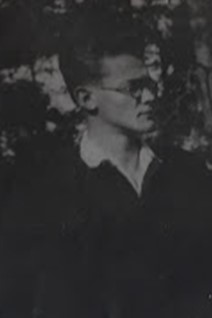
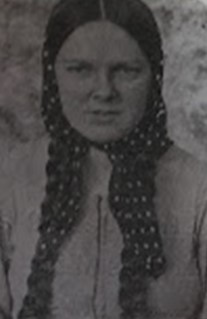
Hans-Hermann & Gertrud Arnold, photos within Police Memorandum Book inscribed ‘Aliens’ Photographs’, H.W.?Owen, MUS/204, Archifdy Ceredigion Archives
In this letter of 22 October 1939, Hans-Hermann also gives an account of attending his tribunal, where he recalled that both Mr Read, a local man and Prof. John E. Neale, the Astor Professor of English History at UCL, came to speak on his behalf. Neale, he recalls, waited with him for over two hours and missed a lecture he was meant to give, as well as inviting him afterwards for coffee at Prof. Reginald Francis Treharne’s house, the Chair of History at the University College of Wales, Aberystwyth, where Neale was staying while the department was evacuated there. While Hans-Hermann was there, he talked to Neale about the Bruderhof, of which the Professor had previously heard. Hans-Hermann also provided a short summary of his tribunal in this letter, as he recalled that:
I was first asked if I was a Jew, and for what religious reasons I had left Germany. Then, to what religious group I belong. I showed them my [Bruderhof] membership card in answer, and then things went very quickly, and I received the stamp “Refugee from Nazi oppression,” with the withdrawal of all limitations. So there is nothing in the way of my studies and we shall have nothing to fear while staying here.
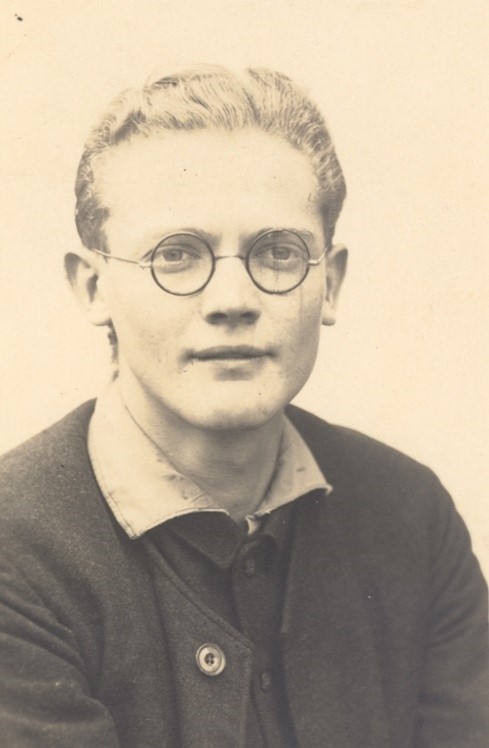
However, this friendly reception was not to last for Hans-Hermann and his family, as by January 1940 in another letter to his mother he revealed that their ‘life here is not so easy’. He indicated that they do not meet anyone who is not pro-war and that he felt he could not say much against it as he would not be heard. This would have been hard for Hans-Hermann, as it would have completely contradicted the pacifist beliefs of the Bruderhof. By mid-1940, their lives in Aberystwyth came to an abrupt end. Gertrud recalled receiving a telegram telling them, with no reason given, to return immediately to the Cotswold Bruderhof. In her memories held at the Bruderhof Historical Archive in New York, she recalled this quick move away from Aberystwyth and the return to the Bruderhof:
We hardly packed anything, but left as we were. We then learned that England wanted to intern all Germans. If we would have stayed in Wales, we could have been sent to Canada or another place because we were not on the Bruderhof. Our members were already interned on our property… The government was friendly, but our neighbours were hostile to us. Because of that the Home Office advised us to emigrate.
The Arnolds emigrated to Paraguay on 24 November 1940. According to Gertrud, Hans-Hermann found this move very hard because he felt there was still a big mission ahead of them in England. They would also be further away from Germany, where he believed that Hitler’s regime would collapse soon. In Paraguay, however, they went on to establish a huge mission, forming three communities alongside the members of the Cotswold Bruderhof who also emigrated there between November 1940 and May 1941. In 1953, Hans-Hermann and Gertrud travelled to the United States to raise money for a hospital they had built in Paraguay. This eventually led to an interest in a community being established in the USA, with the eventual creation of the Woodcrest Bruderhof in New York in June 1954. Hans-Hermann and Gertrud were members of this community until they passed away, with Hans-Hermann dying of cancer there in December 1972.
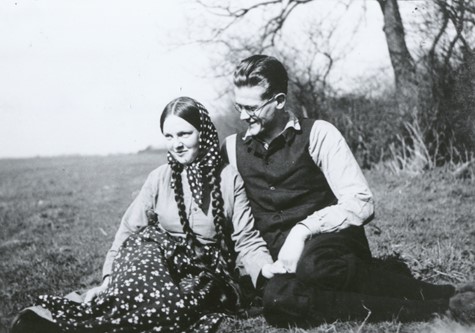
The life stories of Dina, Gertrud, Hans-Hermann, Johanna, Ruth and Stefanie demonstrate that although every refugee had fled National Socialism, their stories and lives were unique and different. Their stories all guided them to Aberystwyth as evacuees from UCL, and each were from different departments: be that History, Psychology or a more general designed degree course. Many of them were also welcomed into the local community, with Ruth teaching German at a local school, and Hans-Hermann and Gertrud being shown the charity of the local student population through the collections they ran for their upkeep, in addition to the support given to Hans-Hermann at his tribunal. These overall experiences mostly indicate a welcoming and friendly reception, but Hans-Hermann’s later letters indicate that their lives walking around the streets and being educated in the seaside town of Aberystwyth also brought some slight tension, mainly with his pacifist beliefs. None were interned, mainly due to interment being imposed on males or, in Hans-Hermann’s case, the Home Office correspondence which advised him to leave England. This was, however, not the fate that some of their fellow male UCL evacuee students and lecturers faced, which will be the focus of the next blog posts.
NB. This blog was written in conjunction with the Aberystwyth at War project. The blog can also be found on their project website.
Sources:
Aigburth Road, Swanage, 1939 Register.
Barth, E. An Embassy Besieged. The Story of a Christian Community in Nazi Germany. Oregon, 2010. Baum, M. Against the Wind. Eberhard Arnold and the Bruderhof. New York, 2015.
Bowlby, J., Ainsworth, M., Boston, M., and Rosenbluth, D. ‘The effects of mother-child separation: A follow-up study.’ British Journal of Medical Psychology, 29 (1956): 211-247.
County of Cardigan Standing Joint Committee Minutes, 3 October 1940, p. 26, Archifdy Ceredigion Archives.
Dina Rosenbluth Internment Exemption Certificate, 1939, The National Archives, HO 396/74.
Eberhard Arnold, Founder of the Bruderhof, Eberhard’s Life and Work, https://rb.gy/8opdia, accessed 3 November 2022.
Gertrud Arnold Internment Exemption Certificate, 1939, The National Archives, HO 396/214.
Gertrud Arnold’s Memories, Bruderhof Historical Archive.
Gilbert, M. Israel: A History. New York, 2014.
Hans-Hermann Arnold Internment Exemption Certificate, 1939, The National Archives, HO 396/214.
Hans-Hermann Arnold, excerpts of translated letters written originally in German sent from Aberystwyth, 14 October 1939-25 April 1940, Bruderhof Historical Archive.
Hans-Hermann Arnold: Summary, Bruderhof Historical Archive.
Johanna Friedstein Internment Exemption Certificate, 1939, The National Archives, HO 396/24.
Kocham, M. Britain’s Internees in the Second World War. London, 1983.
Memories of Prep School in Ceredigion during WWII, 22 February 2022, People’s Voices in a People’s War: Aberystwyth 1939-1945, https://rb.gy/blp2xz, accessed 3 November 2022.
Morgan, P. The University of Wales 1939-1993. Cardiff, 1997.
New York Times, 4 September 1975.
Obituary of Dina Rosenbluth, The Tavistock Gazette, 1983, Harris Meltzer Trust, https://rb.gy/w63gng, accessed 3 November 2022.
Pistol, R. Internment During the Second World War. A Comparative Study of Great Britain and the USA. London, 2017.
Police Memorandum Book inscribed ‘Aliens’ Photographs’, H.W.?Owen, Archifdy Ceredigion Archives, MUS/204.
Randall, I.M. A Christian Peace Experiment. The Bruderhof Community in Britain, 1933-1942. Oregon, 2018.
Restoration of German Citizenship (Article 116 II Basic Law), German Missions in the United Kingdom, https://rb.gy/uyeuvg, accessed 3 November 2022.
Rosenbluth, D. Your Baby. London, 1969.
Rotherwick Road, Hendon, 1939 Register.
Ruth Imgard Bringfriede Liefmann Interment Exemption Certificate, 1939 & 1940, The National Archives, HO 396/55.
Stammers, N. Civil Liberties in Britain During the 2nd World War. Abingdon, 2021.
The London Gazette, 26 November 1946 & 9 October 1991.
Tyldesley, M. No Heavenly Delusion? A Comparative Study of Three Communal Movements. Liverpool, 2003.
University of London. School of Oriental and African Studies. Report of the Governing Board and Statement of Accounts, 1938.
Photos and letters used with the permission of the Bruderhof Historical Archive, Walden, New York & photos used with the permission of Archifdy Ceredigion Archives, Aberystwyth.